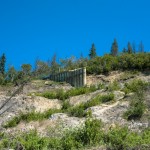Before the highways and railways, there was the North Saskatchewan River. During the 18th and 19th centuries, the Saskatchewan River Route was a significant fur-trading artery. Its 1,300 km route remains mostly navigable to those who dare. Prior to European settlers, it was fundamental to shifts in aboriginal territories. The flood of 1915 resulted in significant economic damage but paved the way for North America’s largest urban park system. While its use has evolved, the river is essential to Edmonton.
Ask someone about the imagery of Edmonton, and you’ll hear about bridges. The High Level, of course, is a common favourite. I personally love the iconic shapes of the Walterdale and Low Level Bridges. Riverdalians and Cloverdalians would likely point to the Downtown Footbridge which – like the Walterdale – may soon succumb to Edmonton’s favourite word: “progress”
From my downtown apartment, I look at the river every day. For much of my adult life, my commute has crossed the river. As a child, my family visited riverside parks and took bike rides running parallel to the river. The North Saskatchewan was always there.
I have a confession: my name is Ester, and I am a river addict.
You see the city in a whole new way from the water. It feels incredible to pass under a bridge, peering up from below. As you sail past downtown, the magnificence of the Hotel MacDonald is undeniable. Passing the Edmonton Queen brings to mind the heyday of Big Island and Sunday picnic riverboat cruises.
Occasionally, another vessel will pass: brisk dragon boats, impressively-styled fishing boats, silent canoes, and river warriors with their speedboats and grinning passengers, waving as they zoom by. During our last expedition, our band of buccaneers saw a bald eagle. Everyone gasped, and everything was magical. Wildlife is plentiful in the ravine. Those with keen eyes might see a beaver, before gliding past flocks of seagulls on sandbars. There are “river wolves” (domestic dogs splashing around) and “river hippies” perched in secret spots with bongos or guitars. Of course don’t forget the ancient lake sturgeon lurking in the sediment below.
River, I love you.
This post originally appeared on Sept 4th, 2014.





